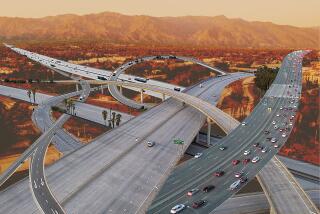Drivers Use of Shortcuts
Your article on cut-through traffic (“Drivers Seeking Shortcuts Raise Hackles in Suburbia,” Aug. 20) was certainly timely. This problem threatens to destroy neighborhoods as we have known them by replacing quiet, relatively safe streets with de facto thoroughfares for commuting drivers who are insensitive to the unfair burden they place on fellow citizens.
In our large Santa Monica neighborhood we have spent over two years building support for a “neighborhood protection plan” consisting of physical measures such as stop signs, restricted turning during rush hours and attractive planters at the end of some residential streets. Plaqued by unacceptable levels of cut-through traffic currently, and faced with 70,000 additional car trips per day that will be generated in the near future by three adjacent projects, residents are willing to accept some inconvenience for themselves if they can enjoy the benefits of reduced traffic, and be assured that emergency vehicles can still reach our homes.
But such plans pose some problems for city governments. They can no longer surreptitiously use residential neighborhoods to absorb commercial traffic. They must confront the problem of excess traffic directly with street improvements, signal synchronization and ride-share programs.
Your article doesn’t mention the most important tool in neighborhoods’ anti-traffic arsenal--insisting that new projects not be built until developers and governments protect neighborhoods from the additional traffic that the projects will generate.
Recently, Santa Monicans and residents of Mar Visa joined together to oppose approval of the “Airport Project,” more than 1 million square feet of commercial space which spelled disaster for Centinela and all the streets around it. Our success in defeating the project was the result of hundreds of volunteer hours: analyzing environmental impact reports to debunk faulty traffic analyses; demonstrating that the financial projections were overly optimistic and misleading; distributing lawn signs to raise public consciousness; collecting signatures on petitions, etc.
JENNIFER L. POLHEMUS
Communications Director
Friends of Sunset Park, Santa Monica
More to Read
Sign up for Essential California
The most important California stories and recommendations in your inbox every morning.
You may occasionally receive promotional content from the Los Angeles Times.









